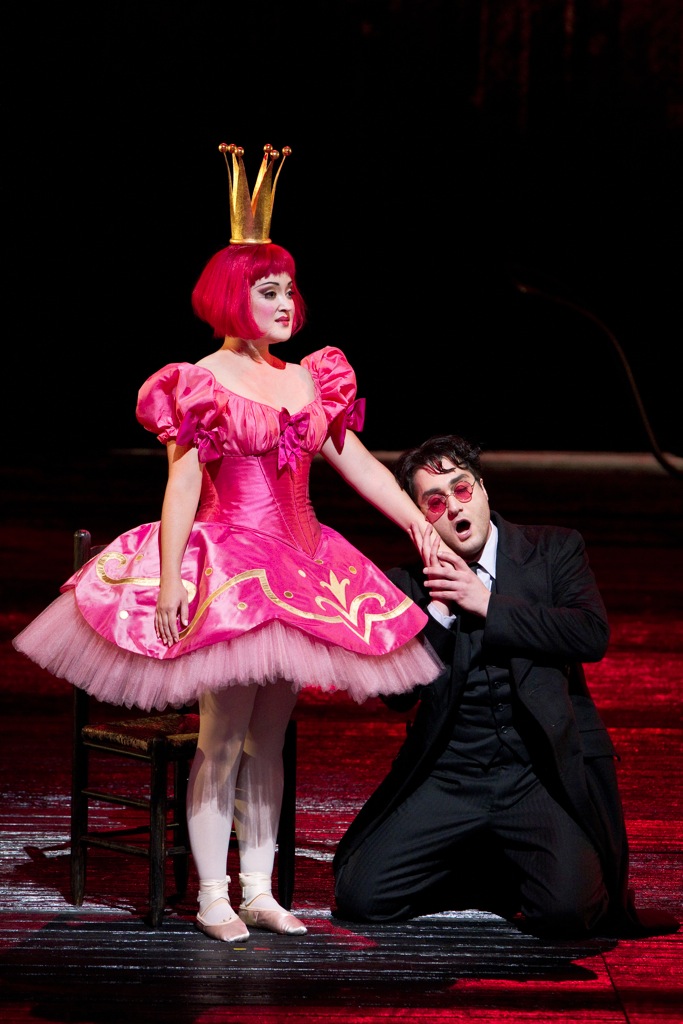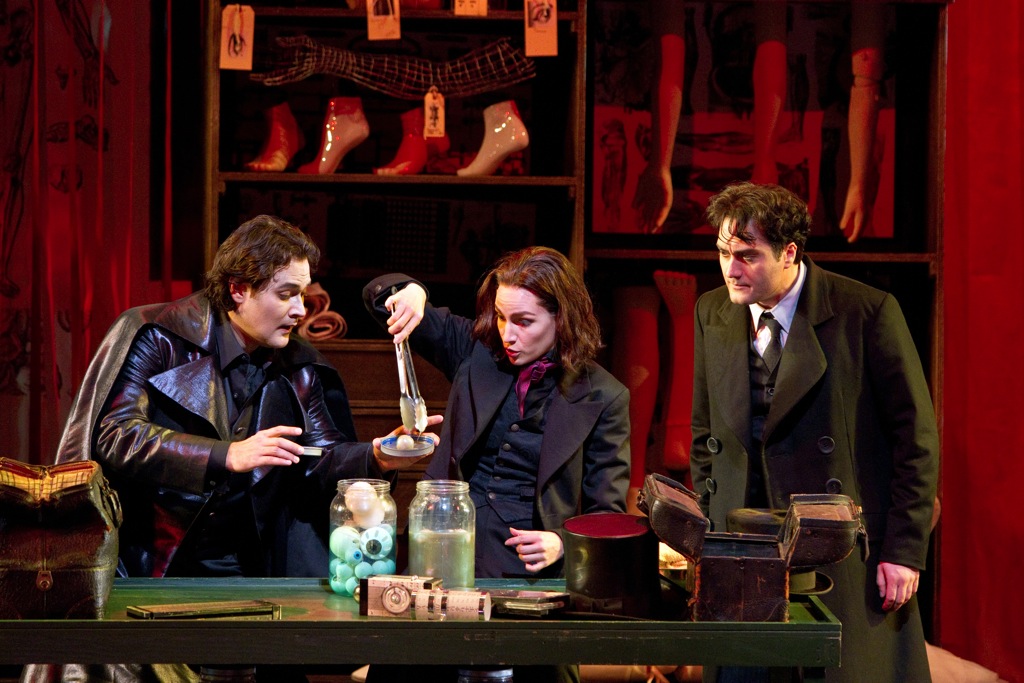Met’s “Hoffmann” proves better the second time around

Anna Christy as Olympia and Giuseppe Filianoti as Hoffmann in the Metropolitan Opera's production of Offenbach's "Les Contes d'Hoffmann." Photo: Marty Sohl/Metropolitan Opera
Bartlett Sher’s production of Les Contes d’Hoffmann made a mixed impression at the Metropolitan Opera when it was introduced last December, but it was born under unfavorable stars. For diverse reasons, Rolando Villazón, René Pape and Elina Garanča all dropped out of the announced cast, and Anna Netrebko, originally slated to assay Hoffmann’s multiple loves, chose to narrow her involvement to merely one, Antonia, along with the non-singing role (in this production) of Stella.
The Met managed to line up some able replacements, but disappointment over the cast may have tainted initial reactions to the production itself. Then too, advance word that Sher would seize on Offenbach’s supposed status as a Jewish outsider living in Paris—a dubious proposition to begin with—to characterize Hoffmann seemed less than promising. And in the event, some found the production to be overly busy.
Returning Tuesday evening as the second performance of the Met’s new season with an almost entirely new cast, Hoffmann came off well. For one thing, the idea of the poet Hoffmann as Jewish outsider has apparently gone by the boards. At the premiere last year, he reportedly donned a white prayer shawl and embraced his faith at the opera’s close. This time he just put on a hat and sat before a typewriter, looking for all the world as if he chose to embrace his art instead, which is pretty much what Hoffmann is about.
Sher does focus on the dark side by, among other things, suggesting a degree of mental instability on Hoffmann’s part, but there is much in the opera to back up this approach. And the swirling crowds in every scene except, strikingly, the central Antonia act, reinforce the idea that much is blurred in Hoffmann’s alcohol-impaired mind.
The doll Olympia, for instance, not only appears in multiple guises, but these guises turn up later in the Venetian act. And you would have to be prudish to object to the aura of sexual languor that infuses that scene. In addition to some suggestive leggy choreography, the stage is graced by several girls wearing just pasties and thongs. They too had appeared in earlier scenes.
More important, the cast is stronger than last year’s. As Hoffmann, tenor Giuseppe Filianoti, who made his Met debut in 2005 in Lucia di Lammermoor, again shows himself to be a most valuable artist. He may not be a paragon of French style, but his handsome, Italianate voice was a pleasure to behold and he sang with much fervor. Occasionally, the voice tightened a bit or briefly lost its tonal focus, but it stood up well in this demanding role, allowing for some especially passionate singing even late in the evening when he launched into the stirring opening of the duet with Giulietta.

Ildar Abdrazakov (Coppelius), Kate Lindsey (Nicklausse) and Giuseppe Filianoti (Hoffmann). Photo: Marty Sohl/Metropolitan Opera.
Another welcome addition to the cast is bass Ildar Abdrazakov, who offers a robustly sung, deftly characterized portrayal of the Four Villains. His rich, chocolaty sound helps make him a real presence as Hoffmann’s nemesis, and in this production he is allowed the aria Scintille diamant. Strictly speaking, this aria has no place in the opera, since it was added by others after Offenbach’s death. But it does allow the singer a choice opportunity for lyricism, one that Abdrazakov embraced with vocal suavity.
Kate Lindsey, in the dual role of Hoffmann’s Muse and his friend Nicklausse, is the one singer with a major assignment who returns from last year. As before, her sterling singing ensures that the Violin aria of the Antonia act, sung with real commitment, and the moving apotheosis finale, Des cendres de don Coeur, emerge as the proper high points of the opera.
Again, Hoffmann’s love interests, rather than entrusted to a single woman, as is ideal, are allocated to three singers. Here the focus was on Hibla Gerzmava, a star of Moscow’s Stanislavsky and Nemirovich-Danchenko Music Theater, in her Met debut as Antonia. As the physically fragile would-be singer, Gerzmava brought a voice of power but also much beauty, which she deployed with a fine feeling for expressive nuance. Aside from a couple of shrieky high notes, hers was a first-rate portrayal. In another successful debut, the Albanian mezzo Enkelejda Shkosa sang Giulietta with a voice of sumptuous richness but it too betrayed signs of stridency on top. Soprano Anna Christy chirped prettily as Olympia.
Joel Sorensen, as the Four Servants, and Wendy White, as Antonia’s mother, also did well.
The conductor Patrick Fournillier, in his Met debut, also made a good impression. Ensemble was not always ideal, but his reading had verve and spontaneity.
It remains disappointing, however, that the Met’s basic performing text is the old Choudens edition and that the company has not taken sufficient advantage of recent scholarship concerning this textually problematic opera. But at least the acts are performed in the right order and important music for the Muse/Nicklausse is included.
Les Contes d’Hoffmann runs through Oct. 19. metoperafamily.org; 212-362-6000.